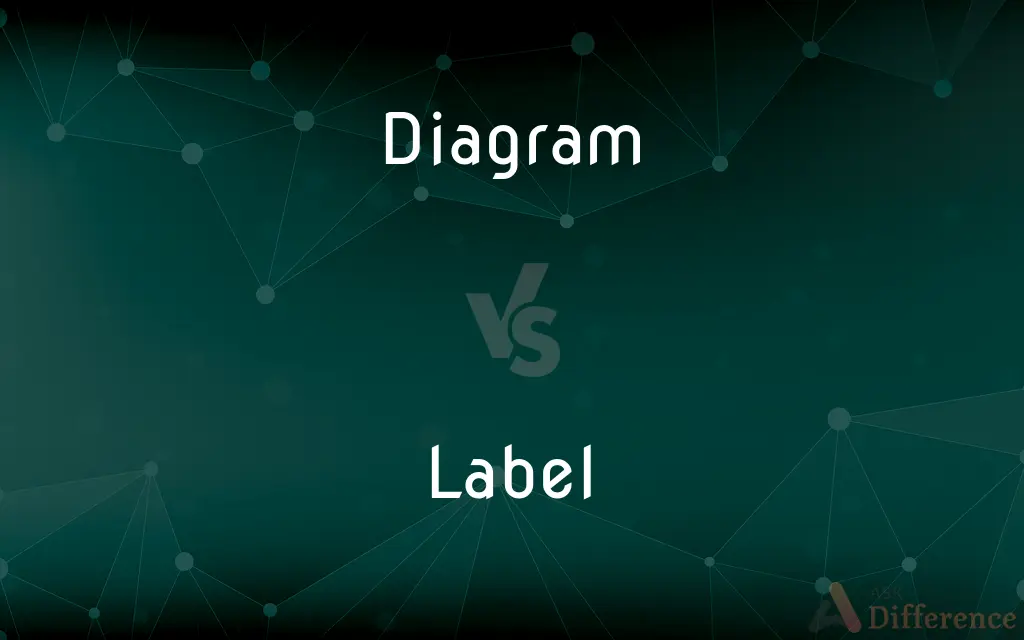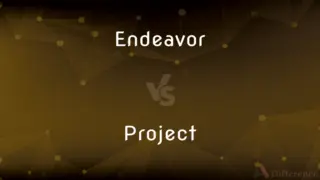Diagram vs. Label — What's the Difference?
By Fiza Rafique & Urooj Arif — Updated on March 20, 2024
A diagram visually represents data or processes, often complex, through shapes and symbols; a label identifies or describes an item or concept, usually with concise text.

Difference Between Diagram and Label
Table of Contents
ADVERTISEMENT
Key Differences
Diagrams are tools for visual communication, effectively breaking down and illustrating complex information, processes, or systems through a combination of shapes, lines, and symbols. These graphical representations can simplify the understanding of intricate relationships and hierarchies. Labels, on the other hand, serve as identifiers or descriptors, providing direct information or categorization to objects, concepts, or data. They use text or symbols to convey brief, essential details about something, making it easily identifiable or understandable.
While diagrams often require interpretation and a certain level of knowledge to be fully understood, they enable the visual synthesis of information, facilitating a deeper comprehension of the subject matter. Labels are more straightforward, aiming to deliver immediate clarity or classification with minimal interpretation needed. This directness makes labels indispensable in daily life, from product packaging to organizing information.
Diagrams can be varied in their forms, including flowcharts, mind maps, and circuit diagrams, each tailored to represent different types of information or processes visually. This versatility allows for their application across numerous fields such as engineering, education, and management. Labels, whereas, are universally utilized in their format, varying mostly in content rather than structure, and are found in contexts as diverse as laboratories, libraries, and supermarkets.
The creation of a diagram involves a process of abstraction, where real-world information is distilled into a series of interconnected symbols and lines. This abstraction facilitates a holistic view of the information, emphasizing relationships and processes. Labels, on the other hand, often highlight specific attributes or categories, grounding them in directness and simplicity without the need for abstraction.
Diagrams and labels, while different in their purpose and design, often work in tandem. A diagram might contain labels to enhance clarity and provide specific details about its components. Conversely, labels can include small diagrams or icons to visually summarize their textual information, enhancing comprehension and engagement.
ADVERTISEMENT
Comparison Chart
Purpose
To illustrate complex information or processes visually
To identify, describe, or categorize an item or concept
Representation
Uses shapes, lines, and symbols
Uses text and/or symbols
Complexity
Can be complex, requiring interpretation
Straightforward, with minimal need for interpretation
Usage
In fields like engineering, education, and management
On products, for organization, in libraries, etc.
Process of Creation
Involves abstraction of real-world information
Highlights specific attributes or categories
Compare with Definitions
Diagram
A tool for organizing and displaying information in a structured manner.
We used a Venn diagram to compare the two theories.
Label
A piece of information attached to an item for identification or description.
The label on the bottle listed the ingredients and nutritional information.
Diagram
A schematic representation highlighting relationships between different components.
The biology textbook featured a diagram of the human circulatory system.
Label
A tool for organization and easy identification in various settings.
She used labels to organize the files in her office by priority.
Diagram
A visual representation using symbols and shapes to explain a concept or process.
The engineer drew a circuit diagram to explain the electrical system.
Label
A categorization or designation given to an individual or item.
The library books were sorted by labels indicating their genres.
Diagram
A graphical illustration of data, often used in presentations and reports.
The marketing report included a diagram showing sales trends.
Label
A tag or sticker on a product providing details about it.
The clothing label showed the fabric composition and washing instructions.
Diagram
An aid for understanding and solving problems by visual means.
The team created a flow diagram to map out the project process.
Label
A brief description or name given to a diagram or part of it for clarity.
Each part of the machine was clearly marked with a label.
Diagram
A diagram is a symbolic representation of information using visualization techniques. Diagrams have been used since ancient times on walls of caves, but became more prevalent during the Enlightenment.
Label
A label (as distinct from signage) is a piece of paper, plastic film, cloth, metal, or other material affixed to a container or product, on which is written or printed information or symbols about the product or item. Information printed directly on a container or article can also be considered labelling.
Diagram
A simplified drawing showing the appearance, structure, or workings of something; a schematic representation
A diagram of the living room
Label
An item used to identify something or someone, as a small piece of paper or cloth attached to an article to designate its origin, owner, contents, use, or destination.
Diagram
Represent (something) in graphic form
The experiment is diagrammed on page fourteen
Label
A descriptive term; an epithet.
Diagram
A plan, sketch, drawing, or outline designed to demonstrate or explain how something works or to clarify the relationship between the parts of a whole.
Label
A distinctive name or trademark identifying a product or manufacturer, especially a recording company.
Diagram
(Mathematics) A graphic representation of an algebraic or geometric relationship.
Label
(Architecture) A molding over a door or window; a dripstone.
Diagram
A chart or graph.
Label
(Heraldry) A figure in a field consisting of a narrow horizontal bar with several pendants.
Diagram
To indicate or represent by or as if by a diagram.
Label
(Chemistry) See tracer.
Diagram
A plan, drawing, sketch or outline to show how something works, or show the relationships between the parts of a whole.
Electrical diagrams show device interconnections.
Label
To attach a label to
Labeled the jars before storing them.
Diagram
A graph or chart.
Label
To identify or designate with a descriptive term; describe or classify
"He missed two crucial penalty kicks ... and was labeled a loser by the previously loyal British press" (Phil Ball).
Diagram
(category theory) A functor from an index category to another category. The objects and morphisms of the index category need not have any internal substance, but rather merely outline the connective structure of at least some part of the diagram's codomain. If the index category is J and the codomain is C, then the diagram is said to be "of type J in C".
Label
(Chemistry) To add a tracer to (a compound).
Diagram
(transitive) To represent or indicate something using a diagram.
Label
A small ticket or sign giving information about something to which it is attached or intended to be attached.
We laughed at her because the label was still on her new sweater.
The label says this silk scarf should not be washed in the washing machine.
Although the label priced this poster at three pounds, I got it for two.
Diagram
(UK) To schedule the operations of a locomotive or train according to a diagram.
Label
A name given to something or someone to categorise them as part of a particular social group.
Ever since he started going to the rock club, he's been given the label "waster".
Diagram
A figure or drawing made to illustrate a statement, or facilitate a demonstration; a plan.
Label
(music) A company that sells records.
The label signed the band after hearing a demo tape.
Diagram
Any simple drawing made for mathematical or scientific purposes, or to assist a verbal explanation which refers to it; a mechanical drawing, as distinguished from an artistical one.
Label
(computing) A user-defined alias for a numerical designation, the reverse of an enumeration.
Storage devices can be given by label or ID.
Diagram
To put into the form of a diagram.
Label
(computing) A named place in source code that can be jumped to using a GOTO or equivalent construct.
Diagram
A drawing intended to explain how something works; a drawing showing the relation between the parts
Label
(heraldry) A charge resembling the strap crossing the horse’s chest from which pendants are hung.
Diagram
Make a schematic or technical drawing of that shows how things work or how they are constructed
Label
(obsolete) A tassel.
Label
A small strip, especially of paper or parchment (or of some material attached to parchment to carry the seal), but also of iron, brass, land, etc.
Label
A piece of writing added to something, such as a codicil appended to a will.
Label
(historical) A brass rule with sights, formerly used with a circumferentor to take altitudes.
Label
(architecture) The projecting moulding by the sides, and over the tops, of openings in mediaeval architecture.
Label
In mediaeval and later art, a representation of a band or scroll containing an inscription.
Label
(graphical user interface) A non-interactive control or widget displaying text, often used to describe the purpose of another control.
Label
(transitive) To put a label (a ticket or sign) on (something).
The shop assistant labeled all the products in the shop.
Label
(ditransitive) To give a label to (someone or something) in order to categorise that person or thing.
He's been unfairly labeled as a cheat, although he's only ever cheated once.
Label
(biochemistry) To replace specific atoms by their isotope in order to track the presence or movement of this isotope through a reaction, metabolic pathway or cell.
Label
(biochemistry) To add a detectable substance, either transiently or permanently, to a biological substance in order to track the presence of the label-substance combination either in situ or in vitro
Label
A tassel.
Label
A slip of silk, paper, parchment, etc., affixed to anything, and indicating, usually by an inscription, the contents, ownership, destination, etc.; as, the label of a bottle or a package.
Label
A slip of ribbon, parchment, etc., attached to a document to hold the appended seal; also, the seal.
Label
A writing annexed by way of addition, as a codicil added to a will.
Label
A barrulet, or, rarely, a bendlet, with pendants, or points, usually three, especially used as a mark of cadency to distinguish an eldest or only son while his father is still living.
Label
A brass rule with sights, formerly used, in connection with a circumferentor, to take altitudes.
Label
The name now generally given to the projecting molding by the sides, and over the tops, of openings in mediæval architecture. It always has a square form, as in the illustration.
Label
In mediæval art, the representation of a band or scroll containing an inscription.
Label
To affix a label to; to mark with a name, etc.; as, to label a bottle or a package.
Label
To affix in or on a label.
Label
A brief description given for purposes of identification;
The label Modern is applied to many different kinds of architecture
Label
Trade name of a company that produces musical recordings;
The artists and repertoire department of a recording label is responsible for finding new talent
Label
A radioactive isotope that is used in a compound in order to trace the mechanism of a chemical reaction
Label
An identifying or descriptive marker that is attached to an object
Label
Assign a label to; designate with a label;
These students were labelled `learning disabled'
Label
Attach a tag or label to;
Label these bottles
Label
Pronounce judgment on;
They labeled him unfit to work here
Label
Distinguish (as a compound or molecule) by introducing a labeled atom
Label
Distinguish (an element or atom) by using a radioactive isotope or an isotope of unusual mass for tracing through chemical reactions
Common Curiosities
How do diagrams help in understanding complex concepts?
Diagrams simplify complex concepts by visually breaking down information, highlighting relationships, and facilitating a holistic view.
What is a label?
A label is a piece of information attached to an item that identifies, describes, or categorizes it, usually through the use of text or symbols.
Can a diagram include labels?
Yes, diagrams often include labels to enhance clarity by providing specific details about the components or steps represented.
What is a diagram?
A diagram is a visual representation that illustrates complex information, processes, or systems through the use of symbols, shapes, and lines.
In what situations are labels most useful?
Labels are most useful for providing immediate clarity, categorization, or identification of items in a wide range of contexts, from products to organization systems.
How do labels contribute to information organization?
Labels contribute to organization by categorizing and identifying items, making them easier to find and understand.
Are labels only textual?
No, labels can also include symbols or small diagrams to visually summarize or complement the textual information.
How do diagrams and labels interact in documentation?
In documentation, diagrams and labels interact by combining visual and textual elements to enhance understanding and clarity.
What types of diagrams are there?
There are many types of diagrams, including flowcharts, mind maps, circuit diagrams, and organizational charts, each serving different purposes.
What makes a good diagram?
A good diagram is clear, accurately represents the information or process, and is easy to understand by its intended audience.
Can labels be used for categorization?
Yes, labels are frequently used to categorize items, making them an essential tool in libraries, stores, and digital data management.
How do diagrams aid in problem-solving?
Diagrams aid in problem-solving by mapping out processes or relationships, which helps in identifying issues and their solutions.
What information do labels typically provide?
Labels typically provide essential information such as names, descriptions, instructions, ingredients, or classifications.
Why are labels important in product packaging?
Labels are important in product packaging for providing consumers with vital information about the product, including usage instructions, ingredients, and safety warnings.
Do all diagrams need labels to be effective?
While not all diagrams require labels to be effective, labels can greatly enhance a diagram's clarity and usefulness by providing detailed context.
Share Your Discovery

Previous Comparison
Endeavor vs. Project
Next Comparison
Julienne vs. MandolineAuthor Spotlight
Written by
Fiza RafiqueFiza Rafique is a skilled content writer at AskDifference.com, where she meticulously refines and enhances written pieces. Drawing from her vast editorial expertise, Fiza ensures clarity, accuracy, and precision in every article. Passionate about language, she continually seeks to elevate the quality of content for readers worldwide.
Co-written by
Urooj ArifUrooj is a skilled content writer at Ask Difference, known for her exceptional ability to simplify complex topics into engaging and informative content. With a passion for research and a flair for clear, concise writing, she consistently delivers articles that resonate with our diverse audience.















































